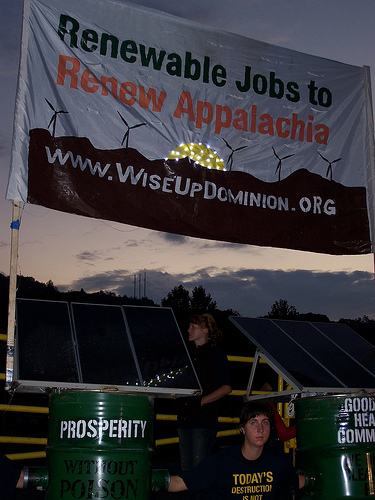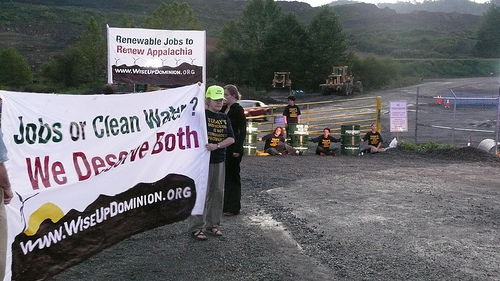
 15 September 2008
15 September 2008
Protesters From Across the Country Join Wise County VA Residents to Oppose Power Plant’s Impact on Environment and Health, and to Demand a Clean Energy Future
At 6:00am this morning around 50 peaceful protesters entered the construction site of Dominion Virginia’s Wise County coal-fired power plant. Almost twenty protesters locked their bodies to eight large steel drums, two of which have operational solar panels affixed to the top that illuminated a banner reading “renewable jobs to renew Appalachia.” In addition to those locked to the construction site, over 25 protesters from across the country convened in front of the plant singing and holding a 10’x30′ banner, which said “we demand a clean energy future.”
In this event—the first protest at Dominion’s $1.8 billion new coal-fired power plant—local Wise County residents have joined hands with those fighting mountaintop removal coal and climate change from Tennessee to California. Those young and old, from cities and from rural communities have come together because the construction of this 585-megawatt power plant not only poses a massive risk to the health of Appalachians, but it also stands in stark opposition to the national move to a clean energy economy.
“Coal is in our blood but we’re realizing it’s also in our lungs and in our drinking water,” said Hannah Morgan, Wise County landowner and one of those locked to the construction site. “We are here because now is the time to take greater action as individuals, a community, and a country to create a sustainable future and stop the destruction of our homeplace.”
“I’m here from Coal River, WV to support my fellow Appalachians in our shared struggle to end coal industry abuses,” said Bo Webb, resident of Coal River, WV and member of Coal River Mountain Watch. “We are not going to continue to stand idly by and watch our children be robbed of their right to clean air and clean water. This is no longer an Appalachian problem, it’s an American problem.”
With very few jobs going to local residents for construction or long-term plant operation and without any means to capture its carbon dioxide pollution, the Dominion plant represents a remarkably bad deal for Virginia. “With all the billions of dollars that have rolled out of Appalachia in the last 5 years, it should look like Dubai but instead it looks like Guatemala,” said Jane Branham, Wise County resident and nurse. “My dad was a coal miner. As he says, ‘it’s not the same as it used to be—there’s no profit in coal for the people here anymore there’s only devastation.'”
This event comes on the heels of Dominion’s groundbreaking ceremony for the plant on August 14 and continues almost two years of opposition to the project. Nearly 45,000 Virginians have signed a petition against the construction of the plant, three lawsuits were recently filed challenging the state’s approval of the plant as its permits fail to adequately control emissions of hazardous toxins, such as mercury, which can cause severe neurological deficits in developing fetuses and young children.
“Embracing clean energy is not a sacrifice, it is an opportunity,” said Rebecca Tarbotton of Rainforest Action Network, a California group that is pressuring Bank of America and Citi, leading financiers of Dominion, to stop funding coal plants and to start investing in clean energy. “This Dominion protest is part of a rapidly growing movement of people across the country who are willing to put their bodies on the line to ensure a clean energy future.”
Opponents to the plant believe Virginia should be leading the country in renewable energy; Virginia’s skilled labor force could be at the forefront of the burgeoning green jobs movement. Leaving Appalachia’s mountains intact could support a 2,000 megawatt wind farm, almost four times the amount of energy generated by this plant.
The plant, if constructed, will process largely mountain top removal coal, creating an even bigger incentive for the destructive practice that decimates historic mountains and contaminates drinking water. Wise County has already had 25% of its historic mountain ranges destroyed forever to mountaintop removal mining.
/For more information or for photos and b-roll, please contact Nell Greenberg, 276-337-3198./
